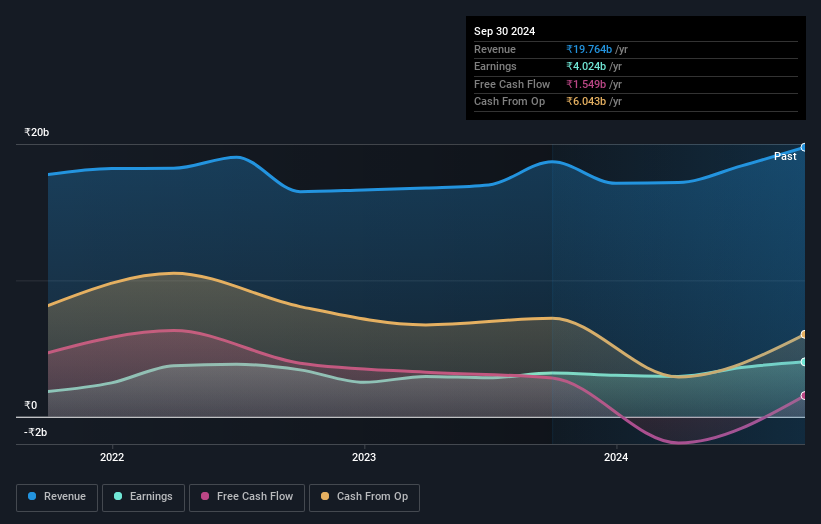- India
- /
- Metals and Mining
- /
- NSEI:HINDCOPPER
Hindustan Copper Limited's (NSE:HINDCOPPER) stock price dropped 4.7% last week; state or government would not be happy

Key Insights
- Hindustan Copper's significant state or government ownership suggests that the key decisions are influenced by shareholders from the larger public
- India owns 66% of the company
- 14% of Hindustan Copper is held by Institutions
Every investor in Hindustan Copper Limited (NSE:HINDCOPPER) should be aware of the most powerful shareholder groups. We can see that state or government own the lion's share in the company with 66% ownership. That is, the group stands to benefit the most if the stock rises (or lose the most if there is a downturn).
As market cap fell to ₹228b last week, state or government would have faced the highest losses than any other shareholder groups of the company.
In the chart below, we zoom in on the different ownership groups of Hindustan Copper.
Check out our latest analysis for Hindustan Copper

What Does The Institutional Ownership Tell Us About Hindustan Copper?
Institutions typically measure themselves against a benchmark when reporting to their own investors, so they often become more enthusiastic about a stock once it's included in a major index. We would expect most companies to have some institutions on the register, especially if they are growing.
We can see that Hindustan Copper does have institutional investors; and they hold a good portion of the company's stock. This can indicate that the company has a certain degree of credibility in the investment community. However, it is best to be wary of relying on the supposed validation that comes with institutional investors. They too, get it wrong sometimes. If multiple institutions change their view on a stock at the same time, you could see the share price drop fast. It's therefore worth looking at Hindustan Copper's earnings history below. Of course, the future is what really matters.

Hedge funds don't have many shares in Hindustan Copper. Looking at our data, we can see that the largest shareholder is India with 66% of shares outstanding. With such a huge stake in the ownership, we infer that they have significant control of the future of the company. For context, the second largest shareholder holds about 5.7% of the shares outstanding, followed by an ownership of 2.4% by the third-largest shareholder.
Researching institutional ownership is a good way to gauge and filter a stock's expected performance. The same can be achieved by studying analyst sentiments. Our information suggests that there isn't any analyst coverage of the stock, so it is probably little known.
Insider Ownership Of Hindustan Copper
While the precise definition of an insider can be subjective, almost everyone considers board members to be insiders. The company management answer to the board and the latter should represent the interests of shareholders. Notably, sometimes top-level managers are on the board themselves.
Insider ownership is positive when it signals leadership are thinking like the true owners of the company. However, high insider ownership can also give immense power to a small group within the company. This can be negative in some circumstances.
Our data cannot confirm that board members are holding shares personally. Not all jurisdictions have the same rules around disclosing insider ownership, and it is possible we have missed something, here. So you can click here learn more about the CEO.
General Public Ownership
With a 20% ownership, the general public, mostly comprising of individual investors, have some degree of sway over Hindustan Copper. While this size of ownership may not be enough to sway a policy decision in their favour, they can still make a collective impact on company policies.
Next Steps:
It's always worth thinking about the different groups who own shares in a company. But to understand Hindustan Copper better, we need to consider many other factors. Consider for instance, the ever-present spectre of investment risk. We've identified 1 warning sign with Hindustan Copper , and understanding them should be part of your investment process.
Of course this may not be the best stock to buy. Therefore, you may wish to see our free collection of interesting prospects boasting favorable financials.
NB: Figures in this article are calculated using data from the last twelve months, which refer to the 12-month period ending on the last date of the month the financial statement is dated. This may not be consistent with full year annual report figures.
Valuation is complex, but we're here to simplify it.
Discover if Hindustan Copper might be undervalued or overvalued with our detailed analysis, featuring fair value estimates, potential risks, dividends, insider trades, and its financial condition.
Access Free AnalysisHave feedback on this article? Concerned about the content? Get in touch with us directly. Alternatively, email editorial-team (at) simplywallst.com.
This article by Simply Wall St is general in nature. We provide commentary based on historical data and analyst forecasts only using an unbiased methodology and our articles are not intended to be financial advice. It does not constitute a recommendation to buy or sell any stock, and does not take account of your objectives, or your financial situation. We aim to bring you long-term focused analysis driven by fundamental data. Note that our analysis may not factor in the latest price-sensitive company announcements or qualitative material. Simply Wall St has no position in any stocks mentioned.
About NSEI:HINDCOPPER
Hindustan Copper
Engages in the exploration, exploitation, and mining of copper and copper ores in India.
Excellent balance sheet with proven track record.
Similar Companies
Market Insights
Community Narratives




